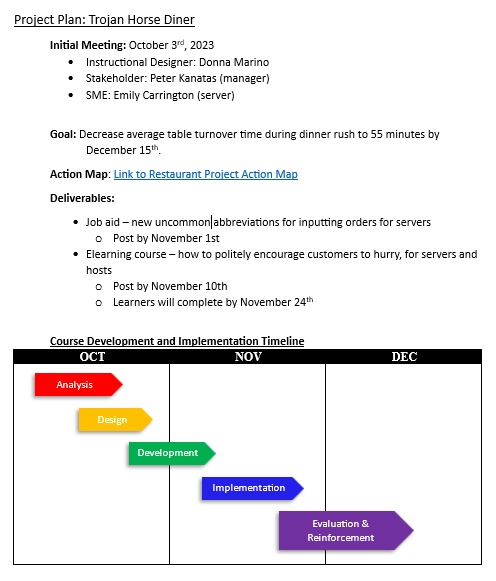Here, I walk you through a hypothetical business situation in which my needs analysis, design, development, and evaluation were able to solve a client’s problem.
The Problem and Solution
A manager at a Diner, was looking to increase the number of guests coming to the restaurant, particularly on weekends. His goal was to decrease average table turnover time during the dinner rush to 55 minutes in two months. One piece of the solution was to train hosts and servers to be more proactive in serving guests, and so I created the scenario-based course, “Make Way for Hungry Guests: Streamlining the Dining Experience”.
Design and Development Process
Action Map
This action map, inspired by the ideas of Cathy Moore, is the product of my discussion with the manager and a server, who were able to serve as subject matter experts. We began by focusing on the goal, which was decreasing table turnover time to 55 minutes in the next two months (dark blue box). From there, we determined what needed to be done to ensure that guests would be able to finish their meals and pay within that timeframe (light blue boxes). We discussed what tasks restaurant staff needed to complete within that timeframe as well as issues that often arise (purple boxes). We identified solutions that, among other actions, included posting job aids and providing training (red boxes).
Created using Figma
Project Plan
Created using Microsoft Word
This project plan was sent to the stakeholders as documentation of the discussion that we had. It includes steps that he and I agreed to take in order to solve the problem (including the course), as well as a timeline for when they would be implemented.
Designing the Course
Created using Canva
Created using Microsoft Word
Created using Microsoft PowerPoint
As part of the design process for the scenario-based course, I created an outline of what the learner’s journey would look like. After speaking again with a server at the restaurant, I was able to write a script filled with best practices as well as common mistakes that hosts and servers make. Her input as SME helped me to incorporate an authentic feel to the training materials during this stage and during the iterations that followed. I also used the restaurant’s logo and colors to create a style guide for the course so that it matched the brand.
Make Way for Hungry Guests: Streamlining the Customer Experience
This is the product of the the iterative design process detailed above.
Created using Articulate Storyline360 and OpenArt
Edited in Adobe Photoshop
Outcome
The diner team was able to reduce table turnover time to 55 minutes by the end of the two month period.
The course was successful in full consideration of Kirkpatrick’s Model for Evaluation. The hosts and servers reacted well to the solutions that were implemented. A majority said they found the course engaging, and all were able to identify at least two new behaviors that they would use. The manager observed them implementing those behaviors in the weeks that followed, which led to the restaurant meeting its goal.








